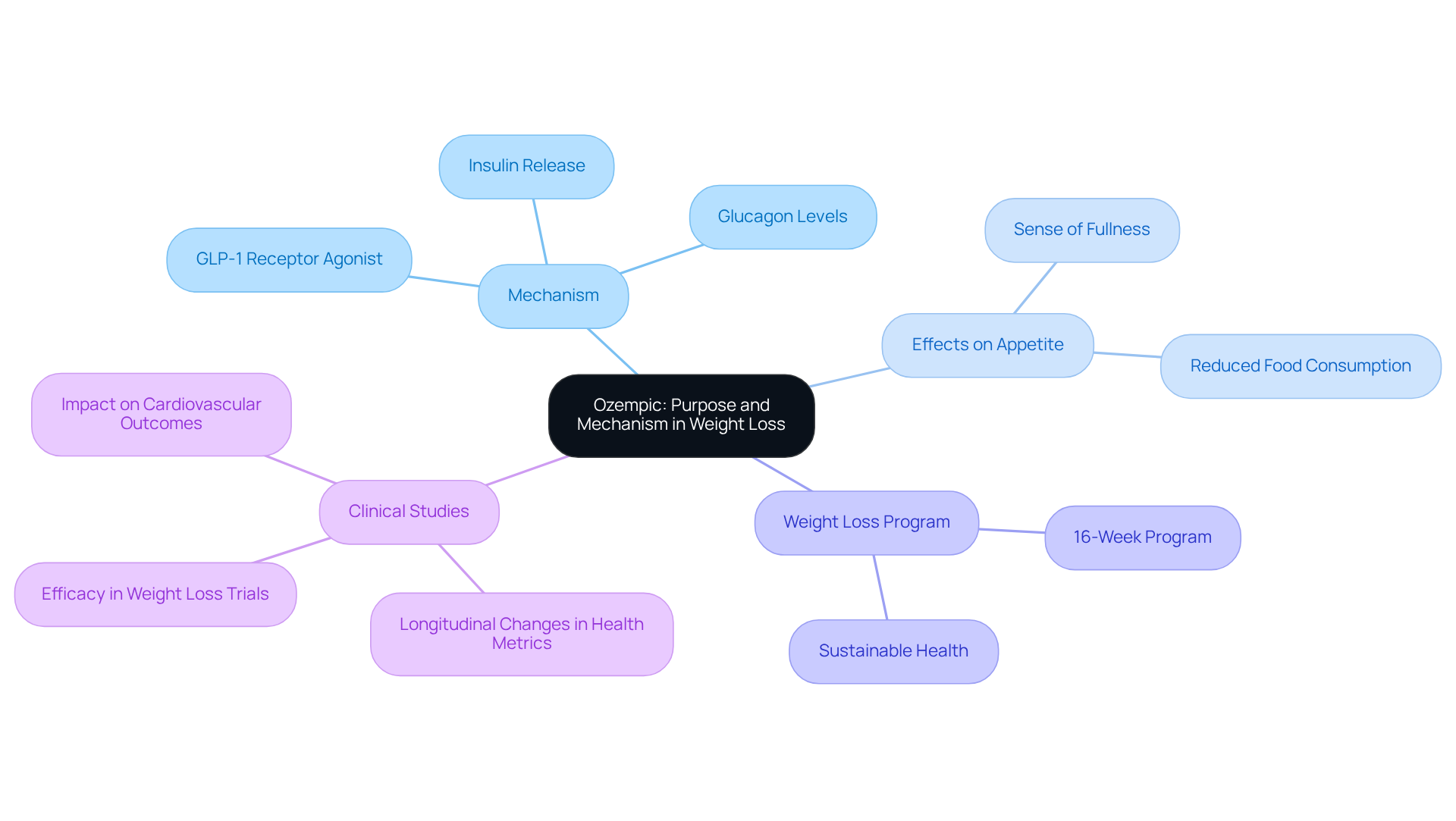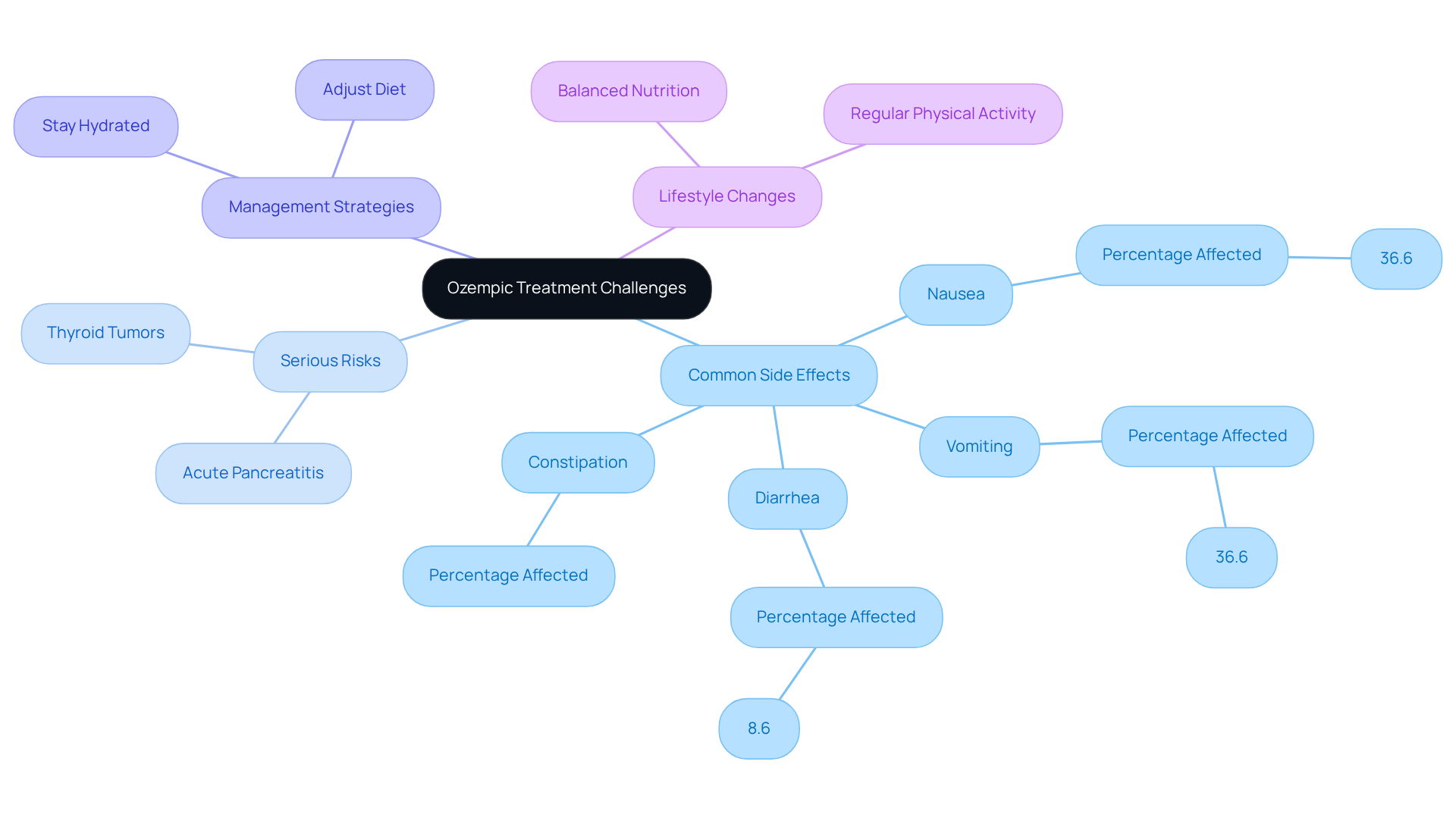Introduction
Managing weight can often feel like an uphill battle. We understand that the rising obesity rates, affecting nearly 100 million individuals in the U.S., can be overwhelming. Among the various treatment options available, Ozempic – a medication originally designed for Type 2 diabetes – has emerged as a potential ally in weight loss efforts.
This article delves into the requirements for using Ozempic in weight management. We’ll explore its mechanism of action, eligibility criteria, and the nuanced challenges that come with its administration. You’re not alone in this journey, and it’s important to consider all aspects before making a decision.
As the quest for effective weight loss solutions intensifies, one must ask:
- Who truly qualifies for this treatment?
- What should be considered before embarking on this journey?
Let’s navigate these questions together.
Defining Ozempic: Purpose and Mechanism in Weight Loss
We understand that managing weight can be a challenging journey. The medication known as semaglutide, a GLP-1 receptor agonist, is primarily approved for treating Type 2 diabetes. It works by mimicking the glucagon-like peptide-1 hormone, which plays a significant role in regulating appetite and glucose metabolism. By boosting insulin release and decreasing glucagon levels, this medication helps lower blood sugar levels.
Moreover, meeting the requirements for ozempic for weight loss involves how semaglutide encourages a sense of fullness, leading to reduced food consumption. At CT Medical Body Transformation & Beyond, we’re excited to offer our groundbreaking 16-week program that harnesses the benefits of this specific medication. Our patients have the opportunity to lose up to 25 lbs or one-third of their body fat in just 120 days.
Clinical studies have shown that individuals using this medication can achieve significant reductions in body mass. This makes it a valuable tool in managing obesity and a crucial part of our personalized, physician-supervised programs that include the requirements for ozempic for weight loss, aimed at promoting sustainable health. You’re not alone in this journey; we’re here to support you every step of the way.

Eligibility Criteria: Who Can Use Ozempic for Weight Loss?
We understand that managing weight can be a challenging journey. The requirements for Ozempic for weight loss primarily focus on individuals with a Body Mass Index (BMI) of 30 or above, categorizing them as obese. Furthermore, those with a BMI of 27 or higher who also face weight-related health conditions, such as hypertension or Type 2 diabetes, may meet the requirements for Ozempic for weight loss.
Although this medication isn’t officially approved for weight loss, healthcare providers can prescribe it off-label, reflecting a growing trend in its use for this purpose. Recent statistics reveal that around 30% of the U.S. population is classified as obese, which translates to about 100 million people. This underscores the critical need for effective weight management solutions.
If you’re curious about this medication, you’re not alone in this journey. We encourage you to have detailed conversations with your healthcare providers to evaluate your suitability based on your personal health profile and treatment objectives. Remember, support is available, and taking that first step can lead to positive changes.

Administration and Dosage: How to Use Ozempic Effectively
We understand that starting a new medication can feel overwhelming. This medication is administered through a subcutaneous injection, typically in the abdomen, thigh, or upper arm. For the first four weeks, the initial dosage is set at 0.25 mg once weekly, allowing your body to acclimate to the treatment. After this adjustment period, you can increase the dosage to 0.5 mg, with further modifications based on your individual response, up to a maximum of 2 mg per week.
At CT Medical Weight Loss & Beyond, we emphasize the importance of personalized medication adjustments and our Customized Nutrition Plan. This approach helps you use the medication effectively for optimal weight loss results. It’s crucial to follow your healthcare provider’s instructions regarding dosage and adhere to the requirements for ozempic for weight loss while maintaining a consistent injection schedule. This method aligns with findings that nearly half of participants on the higher dose lost 20% or more of their body mass, reflecting our commitment to structured support through our 10 Point Touch System.
Moreover, it’s essential to be aware of the requirements for Ozempic for weight loss, including potential side effects such as the risk of pancreatitis and gastrointestinal issues. Our comprehensive medical solutions for reducing body mass ensure that you receive ongoing support tailored to your unique needs. You’re not alone in this journey; success stories like Ericka’s, who achieved an impressive 18 lbs reduction and a decrease in body fat from 31.1% to 22.8%, show that sustainable weight loss is attainable with the right guidance and support.

Understanding Side Effects and Challenges of Ozempic Treatment
We understand that managing body mass can be a challenging journey, and while medication can be effective, it’s important to consider the potential side effects. Many people experience gastrointestinal issues, such as nausea, vomiting, diarrhea, and constipation. In fact, a study involving 175 participants using semaglutide found that 36.6% reported nausea and vomiting, with 8.6% experiencing diarrhea. Although these symptoms often lessen over time, they can be distressing for some individuals.
Moreover, there are more serious risks to be aware of, including acute pancreatitis and the potential for thyroid tumors. This is why it’s crucial for healthcare providers to monitor patients closely. We encourage you to stay informed about these risks and to report any adverse effects promptly. Managing side effects effectively is essential; for instance, staying hydrated and adjusting your diet can help ease gastrointestinal discomfort.
In addition, incorporating lifestyle changes – like balanced nutrition and regular physical activity – can significantly enhance the benefits of Ozempic. This comprehensive approach to health and wellness is something we wholeheartedly support at CT Medical Weight Loss & Beyond. Our priority is personalized care, ensuring that you have the knowledge and support needed to navigate any side effects.
Our dedicated team is committed to tailoring treatment plans that align with your personal health objectives, guiding you safely through your weight loss journey. You’re not alone in this process; we’re here to help. Furthermore, GLP-1 has been shown to be a safe and effective option for weight management, reinforcing our commitment to providing comprehensive care.

Conclusion
Understanding the requirements for Ozempic in weight loss treatment reveals its potential as a valuable tool in managing obesity. Originally designed for Type 2 diabetes, this medication has shown remarkable efficacy in promoting weight loss by regulating appetite and enhancing feelings of fullness. We understand that the journey toward effective weight management can be daunting. However, with the right guidance and support, you can navigate the complexities of Ozempic treatment.
Key insights from the discussion highlight the eligibility criteria for Ozempic, emphasizing the importance of BMI and associated health conditions. Furthermore, the administration and dosage details provide clarity on how to effectively use this medication, ensuring that you can achieve optimal results while being aware of potential side effects. It’s crucial for anyone considering Ozempic to engage in open conversations with their healthcare providers to assess suitability and develop a personalized treatment plan.
Ultimately, the significance of this medication extends beyond mere weight loss; it represents a comprehensive approach to health and wellness. Embracing lifestyle changes alongside Ozempic can amplify its benefits, leading to sustainable weight management. For those on this journey, seeking out professional support and staying informed about the treatment process can pave the way for lasting positive changes. Remember, the path to health is a collaborative effort, and with the right resources and commitment, success is within reach.
Frequently Asked Questions
What is Ozempic and what is its primary purpose?
Ozempic is a medication known as semaglutide, primarily approved for treating Type 2 diabetes. It helps manage weight by mimicking the glucagon-like peptide-1 hormone, which regulates appetite and glucose metabolism.
How does Ozempic work in relation to weight loss?
Ozempic works by boosting insulin release and decreasing glucagon levels, which helps lower blood sugar levels. It also encourages a sense of fullness, leading to reduced food consumption.
What program is offered at CT Medical Body Transformation & Beyond involving Ozempic?
CT Medical Body Transformation & Beyond offers a 16-week program that utilizes the benefits of Ozempic, allowing patients to potentially lose up to 25 lbs or one-third of their body fat in 120 days.
What results have clinical studies shown regarding the use of Ozempic for weight loss?
Clinical studies have shown that individuals using Ozempic can achieve significant reductions in body mass, making it a valuable tool in managing obesity.
How does CT Medical Body Transformation & Beyond support patients using Ozempic?
The program at CT Medical Body Transformation & Beyond is personalized and physician-supervised, aimed at promoting sustainable health and supporting patients throughout their weight loss journey.



